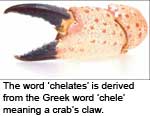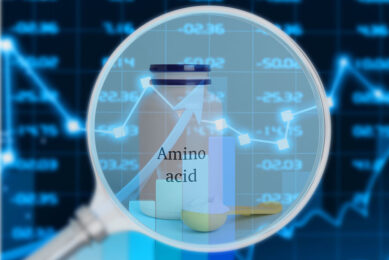Drilling into mineral analysis – structure and stability explained

Despite the confusion and often contradictory information that exists, mineral chelation is a relatively straightforward process governed by some fundamental chemistry basics. By carefully considering factors important in mineral chelation one can begin to distinguish between the products on the basis of biological stability and thus biological bioavailability.
By Richard Murphy, Alltech European Bioscience Centre, Ireland
There are many forms of metal complexes available in the marketplace for use in animal nutrition; and these have been generically entitled ‘organic trace minerals’ by virtue of the fact that the trace elements in question are complexed or otherwise associated with organic molecules. The chemistry of complexation or chelation as it is commonly known has created a great deal of confusion in the animal feed industry. Terms such as metal amino acid complexes, metal amino acid chelates, metal polysaccharide complexes and metal proteinates abound, yet official definitions remain vague and unhelpful.
Generically speaking, the term ‘complex’ can be used to describe the species formed when a metal ion reacts with a molecule or ion (ligand) that contains an atom which has a lone pair of electrons. In the complex, the ligand is bonded to the metal ion through donor atoms such as oxygen, nitrogen or sulphur. Ligands that contain only one donor atom are termed ‘monodentate’, whilst those that contain two or more donor atoms capable of bonding to a metal ion are termed bi-, tri or tetradentate. These multi donor species can also be referred to as polydentate. When such ligands bond to a metal ion via two or more donor atoms on the same ligand, the complex formed contains one or more heterocyclic rings which contain the metal atom. Such complexes are termed as ‘chelates’ (from the Greek; chele, a crab’s claw).
It must be remembered that even though all chelates are complexes, not all complexes are chelates. Indeed whilst the overall theory behind chelation is simple, there are a number of criteria which must be absolutely met in order to ensure the generation of a stable mineral chelate:
• A chelating ligand must contain at least two atoms capable of forming bonds with the metal ion;
• The ligand must form a heterocyclic ring with the metal as the closing member of the ring;
• It must be sterically possible to chelate the metal, and
• The ratio of the ligand to the mineral must meet minimum requirements for stability
True chelates have the ‘ring structure’ formed by bonding between the amino and carboxyl ends of the amino acid and the metal ion.
Amino acids and peptides as ligands
Many different assertions are made as to the relative merits and suitabilities of amino acids versus peptides in forming mineral chelates, with an even greater number of arguments existing in relation to the so-called bioavailability of such products.
When a metal salt such as copper-sulphate is dissolved in water and a bidentate ligand such as an amino acid is added, a series of complexes will be formed. The relative amounts of these complexes present in solution are dependant on both the stabilities of the complexes, the concentrations of ligand and metal present and the solution pH.
Influencing factors such as the pH, the proportion of mineral to ligand and the ionic strength will all play a role in determining the relative stability of such complexes and chelates. In many cases, chelates formed between a metal and di- or tri-peptides will have greater stability than a complex formed by reacting a single amino acid with the mineral (metal).
The stability of metal complexes will ultimately depend on the chemical properties of both the metal ion and the ligand. In terms of the effect of the metal ion on stability, increasing ionic charge and increasing electron affinity will all result in the formation of complexes of higher stability.
The ligand also has several characteristics which are known to influence the stability of complexes including its basicity, the number of metal-chelate rings, the size of the chelate ring, steric effects, resonance effects, and the ligand atom. Since coordination compounds are formed as a result of Lewis acid-base reactions where the metal ion is the acid and the ligand is the base, it follows that in general basic ligands will form more stable complexes.
Comparing chelates
When trying to compare chelates or complexes on the basis of “which is best under this set of conditions”, one really needs to consider many different factors. However, it can be useful to compare products in terms of what’s known as their stability constant.
A stability constant (also known as a formation constant or a binding constant) is an equilibrium value for the formation of a complex or chelate in solution. We can derive this value by measuring the relative proportions of mineral [M], ligand [L] and chelate [ML], thus [L] + [M] ↔ [ML]. Ultimately the stability constant, β, can be defined as a measure of the ratio of the bound mineral concentration to the concentrations of the free mineral and ligand under a given set of conditions. For simplicity it can be represented as follows: β= [ML] / [L][M]
Essentially what this tells us is that the greater the value of the stability constant β, the greater the proportion of bound mineral relative to free ligand ([L]) or free mineral ([M]) at a given pH. Typically, stability constants are presented in log values.
Stability constants
The stability constants for a range of ligands including single amino acids, di-peptides, tri-peptides etc can be readily obtained from the NIST stability constants database which calculates the value taking into account relative pH, ionic strength, temperature, ligand type, ligand and metal concentrations.
Stability constant data can serve as a useful guide when comparing different ligands such as amino acids, dipeptides and tripeptides. In general, the higher the stability constant value, the greater the relative proportion of bound mineral to free mineral and free ligand under a given set of conditions.
Obviously it would be amiss not to state that there will be exceptions to this. Likewise, the very nature of the complex chemistry governing chelation dictates that additional factors will ultimately contribute to stability of ligand-mineral complexes.
Consider the data in Table 1 which gives the stability constants for a range of ligands when complexed with copper under the same physiological conditions. What this indicates is that not only does the type of amino acid influence the stability of a given chelate but that the configuration of amino acids in a peptide can also significantly influence how the ligand and mineral interact. In some instances simply increasing the number of amino acids in a ligand may not increase the stability of the metal complex and thus may not necessarily increase the relative proportion of bound mineral.
In deference to this, if you examine the three tri-peptide chelates in the table (Gly-Gly-Gly, Gly-Gly-His and Gly-His-Gly) you can appreciate that both the overall sequence and position of amino acids in a peptide will greatly affect stability of a chelate.
The substitution of a histidine into the tripeptide Gly-Gly-Gly to yield Gly-Gly-His for instance enhances the stability value and thus the relative proportion of bound mineral (copper in this instance). Furthermore, changing the position of this histidine within the tripeptide sequence (to form Gly-His-Gly for example) can result in a further increase in the stability constant and as such an increase in the proportion of bound mineral.
Type of ligand is essential
In practical terms, simple changes in the configuration of amino acids in this tripeptide result in a greater proportion of bound mineral relative to free mineral and ligand. Essentially, mineral chelate stability can be significantly influenced by not only the type of amino acid but also the configuration of amino acids in a peptide sequence – in essence ligand size isn’t of paramount importance – the type of ligand is.
Individual amino acids exhibit a range of stability constants when complexed with mineral and these can be assessed in a variety of databases. It is reasonable to expect that peptides which have a greater number of donor atoms and hence the potential to form a number of chelate rings when binding to a metal ion would have higher stabilities than simple amino acids such as glycine. This is however dependent on the peptide being able to actually form more than one chelate ring. As in the case of amino acids, peptides also exhibit a range of stabilities. In many instances, the stability of peptide chelates can be greater than single amino acid chelates. From a production standpoint, it is important to note that the extent and type of hydrolysis of a protein source to form short chain peptides can very significantly influence the sequence of amino acids present in these peptides. Research carried out at Alltech’s European Bioscience Centre has demonstrated that production of an ‘optimal’ protein hydrolysate for mineral chelation can be effected through careful selection of the hydrolysis conditions. This ensures that the Bioplex mineral range will have the necessary physico-chemical properties to ensure wide ranging constancy and mineral binding stability under conditions of changing pH.
Source: AllAboutFeed Vol 1 no 4, 2010
 Beheer
Beheer









 WP Admin
WP Admin  Bewerk bericht
Bewerk bericht